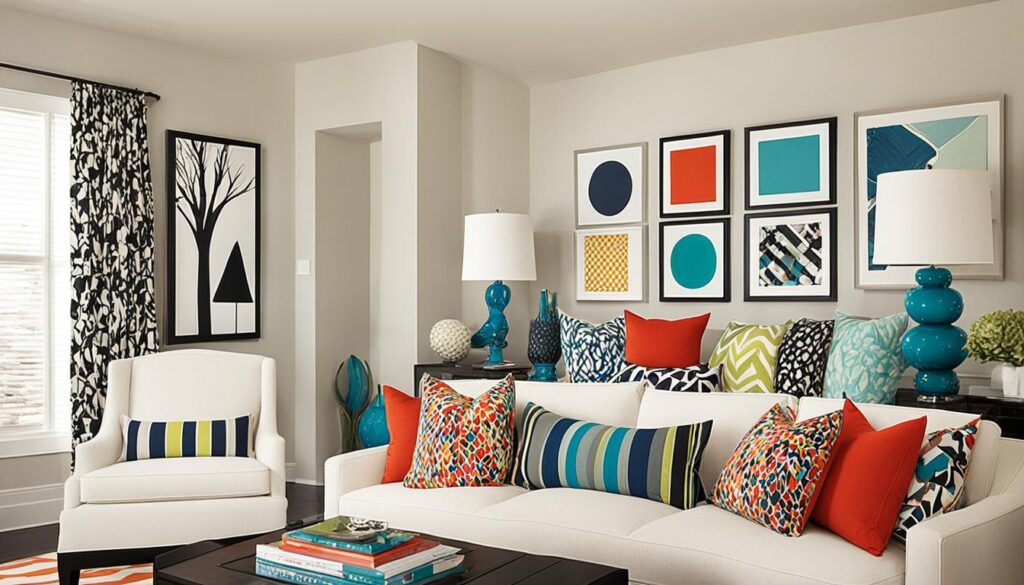Color is more than just an aesthetic choice; it plays a crucial role in shaping the ambiance of your home. Understanding how to use color in interior design can transform your living spaces into vibrant and inviting environments. Not only does color affect the way you feel, but it also influences perceptions of space, making it an essential element of home decor. By delving into color psychology in design, you can unlock the potential of various hues to evoke emotions, create harmony, and define areas within your home.
With so many available color trends in interior design, it’s exciting to explore how different shades can impact everything from creativity to relaxation. For instance, vibrant reds often trigger passion and ambition, making them great for creative spaces like home offices. In contrast, calming blues promote tranquility in bedrooms and bathrooms. Understanding these psychological effects can help you make informed decisions when it comes to your color choices, ultimately enhancing your home’s comfort and aesthetic appeal.
Key Takeaways
- The right colors can evoke specific emotions and enhance the overall mood of a space.
- Red can stimulate appetite, making it ideal for kitchens and dining areas.
- Calming shades like blue promote relaxation in bedrooms and bathrooms.
- Utilizing shades of green fosters a sense of balance and harmony within your home.
- Color psychology plays a significant role in how you perceive and enjoy your living areas.
- Accent colors can add depth and visual interest to any room.
The Importance of Color in Interior Design
Understanding color psychology is fundamental when designing any space. The relationship between colors and emotions can transform your interior design choices, drawing on principles of color psychology in design that emphasize how colors affect emotions. Selecting the right colors involves analyzing their psychological impact on the dwellers of a space.
Understanding Color Psychology
Color plays a vital role in creating atmospheres that reflect the intended purpose of each room. A traditional color wheel emphasizes twelve key hues, including red, blue, and yellow. Each color can evoke distinct feelings. For example, warm colors like red and orange promote enthusiasm and energy, making them suitable for lively areas such as kitchens. In contrast, cooler shades like blue and green bring a sense of calm, often used in spaces designed for relaxation.
How Colors Affect Emotions and Mood
The impact of colors on emotions is profound. Various color schemes can elicit different experiences—monochromatic schemes provide unity, while complementary schemes introduce balance or tension. By employing the 60-30-10 rule, a designer can achieve harmony, where 60% of the space showcases a dominant color, 30% a secondary tone, and 10% an accent. Utilizing color theory effectively ensures that your home not only looks appealing but also resonates with uplifting energy or peacefulness.

How to Use Color in Interior Design
Color plays a pivotal role in shaping your interior space, affecting everything from mood to spatial perception. When considering choosing the right paint color, it helps to understand how different hues can transform a room. The careful selection of shades not only enhances aesthetics but also sets the tone for your environment.
Choosing the Right Paint Colors
Selecting the perfect paint color can significantly influence the overall atmosphere of a room. Light and neutral tones can create an illusion of a larger space, ideal for smaller areas. For added character, consider applying the 60-30-10 rule in interior design, where 60% of the room’s color is dominant, 30% is secondary, and the remaining 10% serves as an accent. This balance creates a harmonious look while featuring bold aspects that catch the eye.
Creating Visual Interest with Color
Creating visual interest in your home requires more than simply painting walls; it involves layering various colors and textures. You can employ techniques like accent walls with deep hues to introduce depth and focal points. Mixing different shades can enhance your space, making it feel inviting and dynamic. Utilizing contrasts through complementary colors can also add drama, encouraging engagement within the room. By thoughtfully applying your color choices, you craft a cohesive design that resonates with your personal style.

Color Theory in Home Decor
Enhancing your home requires an understanding of color theory in home decor. This foundational knowledge can steer your choices, bringing harmony and vibrancy to your living spaces. The basic principles of color theory involve recognizing the color wheel, which features three primary colors: red, yellow, and blue. Mixing these colors creates secondary hues such as green, orange, and purple, while further combinations yield six tertiary colors. These principles are not just theoretical; they can significantly shape the atmosphere of your rooms.
Basic Principles of Color Theory
At the heart of color theory lie various combinations that determine how colors interact and influence each other. You can explore several basic principles of color theory:
- Complementary colors: Colors opposite each other on the color wheel create striking contrasts.
- Analogous color schemes: These involve colors next to each other, producing a cohesive look.
- Triadic color schemes: This approach balances three colors evenly spaced on the color wheel, resulting in a vivid contrast.
- Monochromatic color schemes: Focus on one hue, using variations in shade and tint to add depth.
Complementary, Analogous, and Triadic Color Schemes
Employing complementary and triadic color schemes can elevate your interior design. Complementary colors spark energy and create visual interest, while analogous schemes foster tranquility and cohesion. Triadic color schemes allow exploration of vibrant palettes without chaos, granting versatility and appeal. Understanding the intended use of each space and proportionate application of these schemes ensures your selections resonate well with your desired ambiance.

Incorporating Color Schemes Effectively
Incorporating color schemes effectively can transform your space, offering both aesthetic appeal and functionality. You can choose between monochromatic versus multi-colored palettes based on the ambiance you desire. These choices not only affect visual interest but also influence the overall mood of the room. Understanding how to utilize color wisely will help create an inviting environment.
Monochromatic versus Multi-Colored Palettes
Monochromatic palettes consist of varying shades of a single color, creating a sense of calm and subtlety. This approach allows for a sophisticated, unified look. It works particularly well in smaller spaces, as it can make a room feel more expansive. On the other hand, multi-colored palettes can infuse energy and vibrancy into your home. When using multiple colors, aim to work with 3 to 5 colors to maintain a balanced and cohesive feel. Utilizing too few colors can lead to a matchy-matchy appearance, while using more than 5 colors may overwhelm the senses.
Using Color to Define Spaces
Using color to define spaces within your home enhances functionality and flow. For example, consider using distinct tones in an open-plan layout to delineate different areas. Warm tones can create an inviting atmosphere in social spaces, while cool tones may offer tranquility in relaxation zones. Accessories, textiles, and smaller furniture pieces can introduce additional palette colors, tying everything together seamlessly.

| Palette Type | Key Characteristics | Best Use Cases |
|---|---|---|
| Monochromatic | Simplicity, variations of one color | Small and intimate spaces |
| Multi-Colored | Vibrancy, energy, multiple colors | Open areas, lively environments |
| Complementary | Striking contrast, colors opposite on the wheel | Highlighting features, dramatic styling |
| Analogous | Harmonious, colors adjacent on the wheel | Relaxing aesthetics, cohesive designs |
| Triadic | Balanced, three evenly spaced colors | Vibrant yet balanced spaces |
Implementing these strategies will guide you in making intentional choices that significantly enhance your interior design.
Using Accent Colors Effectively
Accent colors can profoundly enhance your space. Understanding how to select accent colors is key to achieving a well-balanced design. Aim for accent colors to occupy about 10% of your overall color scheme. A recommended balance follows the 60-30-10 rule, where 60% is a dominant color, 30% a secondary color, and 10% an accent color.
How to Select Accent Colors
When selecting the right accent colors, consider the mood and feeling you wish to convey in your space. Using contrast with a neutral backdrop allows bold accent colors to truly shine. For instance, pairing metallic accents with darker shades can create an elegant, glamorous effect. Choosing colors opposite each other on the color wheel can enhance sophistication in formal areas, while adjacent colors bring warmth to casual spaces.
Ideas for Adding Accent Colors in Your Home
There are numerous creative ways for adding accent colors in your home. Here are some effective ideas:
- Introduce colorful throw pillows or blankets for an instant pop of color on neutral furniture.
- Paint a single wall or architectural feature with a vibrant shade to create a striking focal point.
- Add accent colors to furniture using stenciling or free painting techniques.
- Incorporate bright colors in children’s study areas to stimulate focus and creativity.
- Utilize faux dado rails in contrasting colors that can add striking elements to any room.

Experimenting with these ideas encourages personalization in your space while emphasizing the importance of using accent colors effectively. Trust your instincts and don’t hesitate to think outside the box to create a dynamic and inviting environment.
Color Trends in Interior Design
Staying updated with current color trends in interior design allows you to refresh your living space while expressing personal style. The upcoming year, 2024, showcases an exciting palette sure to inspire your next home makeover.
Popular Colors of the Season
Earthy tones like brown, caramel, and beige are leading the charge among popular colors of the season. Warm neutral shades are making a strong impression, with a notable shift toward yellow-based hues. These colors not only bring warmth but also serve as versatile backdrops for various decor styles. Vibrant colors are also emerging as favorites in 2024, including:
- Bold reds
- Sunny yellows
- Lively mid-blues
Soft greens and blues are trending as well, promoting a calming atmosphere within living spaces. The use of playful hues on ceilings, such as Peach Fuzz, showcases a fun approach to incorporating color. This variety of choices allows for creative expression while adhering to contemporary aesthetics.
Timeless Color Choices for Different Styles
Timeless color choices maintain their allure throughout trends. Shades of cream and neutral tones embody elegance and provide a peaceful ambiance. Earthy browns and rusts evoke warmth and seamlessly blend with natural themes. For those leaning into modern designs, sticky notes of dark blue-black add sophistication, particularly in kitchen spaces. Additionally, the soft pastel palette, including lavenders and pale blues, highlights versatility and timeless appeal.
Incorporating these color trends into your home design creates a refreshing yet rooted aesthetic that reflects both contemporary styles and the timeless charm of classic choices.

Creating a Cohesive Color Palette
When designing your home, creating a cohesive color palette lays the foundation for a harmonious aesthetic. It involves balancing bold and neutral colors effectively to avoid visual chaos while keeping the design appealing. Balancing bold and neutral colors allows you to introduce striking hues without overwhelming a space. Consider using soft neutrals for larger areas, such as walls and ceilings, while reserving bold colors for accents, furniture, or decor.
Balancing Bold and Neutral Colors
Incorporating a mix of bold and neutral colors provides depth and character to your interior. Neutral colors often serve as the base, covering 60-70% of your space, while bold hues form the highlights, making up roughly 5-10%. This distribution helps maintain focus on accents without creating chaos. Using analogous colors from the color wheel can also enhance this balance, ensuring a fluid transition from one space to another.
How to Layer Colors for Depth
Layering colors for depth enhances the visual intrigue of a space. This technique involves various shades and tones, allowing you to create a richer experience. For example, employing lighter tints of a specific color in larger areas and deeper shades in accents adds dimension. Use complementary colors to tie any room together, but avoid allowing them to clash with the overall scheme. For open-concept spaces, consider maintaining a consistent shade throughout to foster unity between different areas.

| Color Role | Percentage | Examples |
|---|---|---|
| Base Color | 60-70% | Soft whites, beiges, light grays |
| Secondary Color | 25-30% | Muted greens, warm taupes, gentle blues |
| Accent Color | 5-10% | Vibrant yellows, bold reds, deep blues |
By applying these principles of creating a cohesive color palette, balancing bold and neutral colors, and layering colors for depth, you can achieve an inviting and visually engaging interior.
Conclusion
Using color in interior design is essential for creating spaces that are not only aesthetically appealing but also emotionally nurturing. From the foundational primary colors of the color wheel to the more complex hues, understanding how to use color in interior design allows you to craft environments that resonate with your personal style and emotional needs. By exploring various color harmonies, such as complementing or contrasting palettes, you can highlight features and define areas within your home. Through the art of led installation experience, you can also incorporate color-changing lighting to create different moods and atmospheres within a space. Whether it’s a calming blue for a bedroom or a vibrant red for a dining area, the use of color through LED lighting adds another layer of versatility to your interior design. Overall, mastering the use of color in interior design opens up endless possibilities for expressing creativity and cultivating a personalized living environment.
The effective color application transcends mere decoration—it transforms the ambiance of your living spaces. Warm colors bring energy and vibrancy, while cool tones promote calmness and tranquility. Remember, light shades can open up smaller rooms, making them feel spacious, whereas darker colors add a sense of coziness to larger areas. Embracing a thoughtfully curated color palette will elevate your space and improve the emotional dynamics within it.
Ultimately, color is a powerful tool in your design toolkit. By experimenting with different color combinations—whether it be a monochromatic scheme for harmony or bold splashes of color for vibrancy—you can create environments that reflect your personality and promote well-being. Let your creativity flow, and embrace the transformative power of color in interior design.









